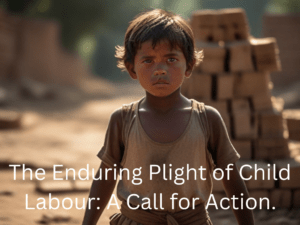Introduction to The Enduring Plight of Child Labour: Child Labour Essay.
Child labour is a persistent issue that deprives millions of children worldwide for their childhood, education, and basic rights. Despite efforts to combat it but child labour continues to thrive in various forms across different regions, reflecting underlying socio-economic challenges. In this Child Labour Essay we explores the causes, consequences, and potential solutions to the problem of child labour, emphasizing the urgent need for collective action to protect the rights and well-being of all children.
Causes of Child Labour.
Several interconnected factors contribute to the prevalence of child labour. Poverty remains one of the primary drivers that forcing families to rely on the income generated by their children to survive. Inadequate access to education perpetuates this cycle, as children are unable to break free from the cycle of poverty without proper schooling. Additionally, cultural norms, lack of enforcement of child labour laws, and demand for cheap labour in industries further exacerbate the problem.
Consequences of Child Labour.
The consequences of child labour are profound and far-reaching, affecting children physically, emotionally, and socially. Working in hazardous conditions exposes children to injuries, illnesses, and even death. Their educational development is stunted, denying them the opportunity to acquire essential skills for their future. Moreover, child labour perpetuates intergenerational poverty by trapping families in a cycle of exploitation and deprivation.
Solutions to Child Labour.
Addressing child labour requires a multi-faceted approach that tackles its root causes while providing support and protection for vulnerable children. Governments must prioritize policies that eradicate poverty, improve access to quality education, and enforce existing labour laws effectively. Collaboration between governments, international organizations, NGOs, and businesses is crucial to implement sustainable solutions. Investing in social protection programs, vocational training, and alternative livelihoods can provide families with viable alternatives to child labour. Furthermore, raising awareness and empowering communities to advocate for children’s rights are essential components of any successful anti-child labour strategy.

Conclusion on Child Labour Essay.
Child labour represents a grave violation of children’s rights and a significant barrier to sustainable development. It is imperative that we work collectively to eliminate this scourge and create a world where every child can enjoy their childhood, receive an education, and pursue their dreams free from exploitation. By addressing the underlying causes of child labour, enforcing laws, and investing in education and social welfare, we can build a brighter future for generations to come. Let us stand united in our commitment to end child labour once and for all.
Frequently Asked questions on child labour
How prevalent is child labour globally?
Child labour remains a widespread issue, with millions of children engaged in various forms of work across different regions and industries worldwide.
What are the common forms of child labour?
Common forms of child labour include agricultural work, domestic service, manufacturing, mining, street vending, and involvement in illicit activities such as drug trafficking and prostitution.
What are the main causes of child labour?
Poverty, lack of access to education, cultural traditions, inadequate enforcement of child labour laws, and demand for cheap labour are among the main causes of child labour.
What are the consequences of child labour?
Child labour has profound consequences on children’s physical health, emotional well-being, and educational development. It exposes them to hazardous conditions, denies them access to education, and perpetuates cycles of poverty.
How does child labour affect education?
Child labour often prevents children from attending school regularly, leading to poor academic performance, high dropout rates, and limited opportunities for future advancement.
What are the legal frameworks addressing child labour?
International conventions such as the International Labour Organization’s (ILO) Convention on the Rights of the Child (CRC) and the Convention on the Worst Forms of Child Labour provide legal frameworks to combat child labour. Additionally, many countries have enacted national laws and policies to address the issue.
What efforts are being made to combat child labour?
Governments, international organizations, NGOs, businesses, and communities are working together to combat child labour through various initiatives, including awareness campaigns, enforcement of laws, provision of social services, and support for education and alternative livelihoods.
How can individuals contribute to the fight against child labour?
Individuals can contribute by supporting ethical consumerism, advocating for children’s rights, volunteering with organizations working on child labour issues, and raising awareness in their communities.
What are some successful interventions to eliminate child labour?
Successful interventions include targeted social protection programs, access to quality education, vocational training for parents and children, enforcement of labour laws, and economic empowerment initiatives for vulnerable families.